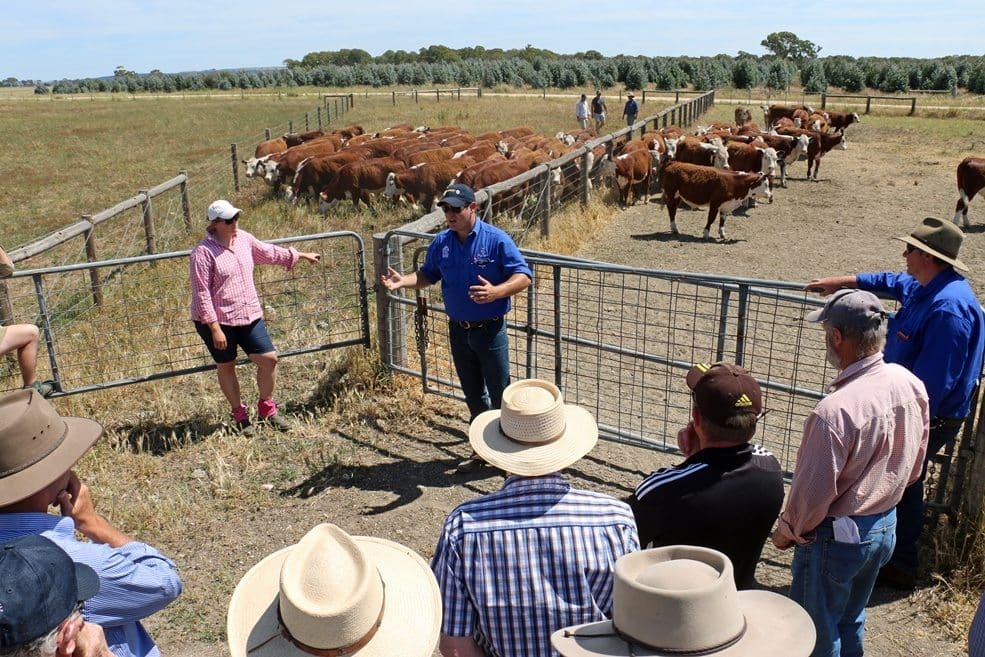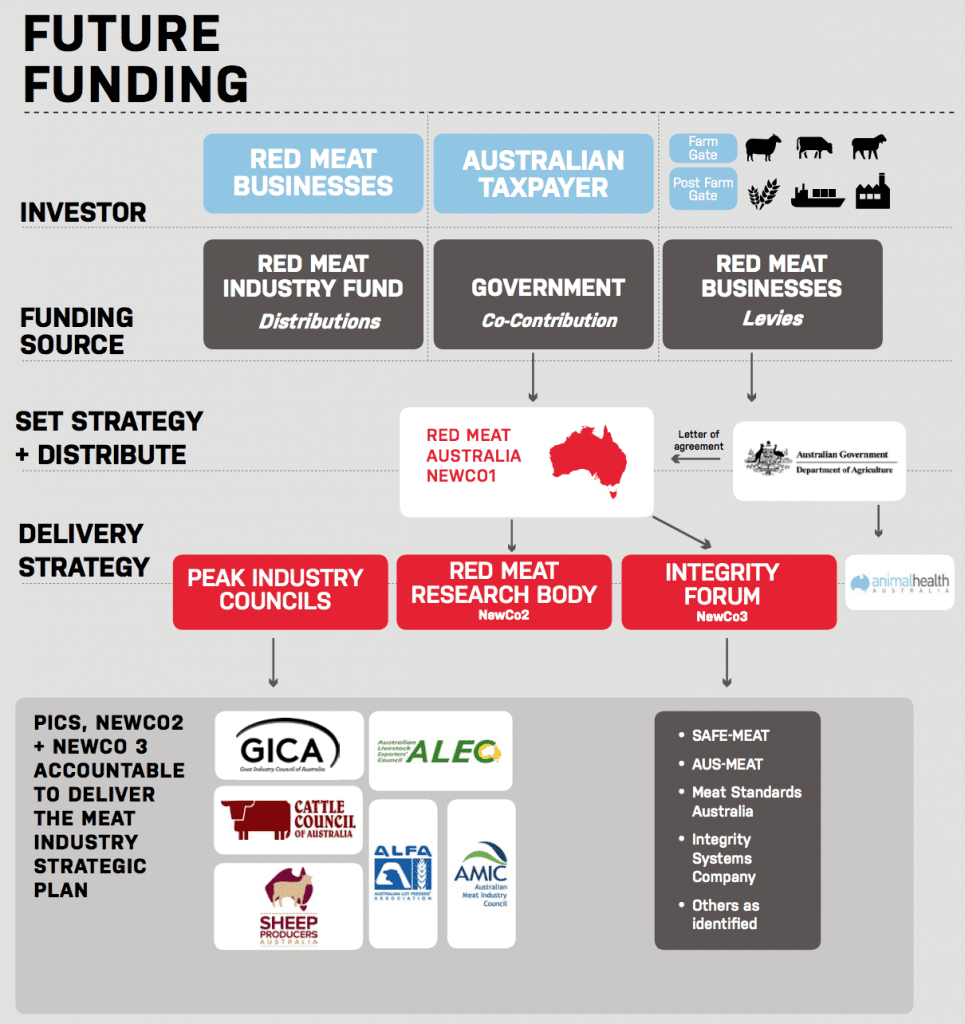AFTER nine months of exploring stakeholder views and contemplating red meat industry restructure options, the chair of the independent taskforce conducting a review of the Red Meat industry Memorandum of Understanding has landed on a preferred vision for the industry’s future.
On a spectrum ranging from no change at one end to radical change at the other, the recommended restructure, which is outlined in a white paper to be formally released at 3pm this afternoon would certainly fall closer to the latter.
It would involve creating a new industry body, with a current working title of Red Meat Australia, to oversee the strategic direction of the red meat industry and to be responsible for driving cultural change across industry.
The full White Paper document can be downloaded on the RMAC website here
Red Meat Australia would oversee all levy expenditure in future, have the power to set policy for whole of red meat supply chain issues, and would be responsible for holding all signatories to the MoU and Meat Industry Strategy Plan accountable for delivering on agreed outcomes.
The new structure would also involve merging all of the red meat industry research and development corporations – Meat & Livestock Australia, the Australian Meat Processing Corporation and Livecorp – into a single body.
The Red Meat Advisory Council (RMAC) would cease to exist.
A third body would also be created to coordinate and manage red meat industry integrity systems including AusMeat, SafeMeat, NLIS and MSA. (more details on the proposed restructure arrangements below)
In a draft copy of the White Paper that has been circulated to some industry peak councils and stakeholders ahead the formal launch, independent review taskforce chair Jim Varghese describes the proposed industry architecture as “nimble, streamlined, cost-effective, unified and able to deal tactically with whatever challenges the red meat industry faces”.
He said the recommended path forward was designed to build confidence and trust across the industry, at all levels of government and the broader community as to the future of the red meat industry in Australia.
Taskforce members say a very clear theme of feedback from industry was the need for a ‘clean line of sight’ between the aspirations of levy payers and industry strategy, and a need to remove duplication and cross overs that exist between existing industry bodies.
The chosen structure builds on, rather than reinvents, the current MoU. Key issues with the existing ‘cumbersome framework’ are that it tends to reinforce division between the different sectors of the red meat supply chain, which constrains industry development, delays responses to critical issues and can allow grass roots driven ideas to get bogged down in various overlapping mechanisms.
The draft white paper document describes the preferred option as “a simple and streamlined structure” that encourages collaboration throughout the chain, provides transparency and also ensure there are appropriate accountabilities and oversights throughout the system.
Jim Varghese AM said the White Paper provides a road map for all sectors of the red meat value chain to work collaboratively from farm gate to plate to maximise future value for the red meat industry.
The review has been set against of a backdrop of a red meat industry faced with growing global demand opportunities, but also increasing challenges from community groups concerned about animal welfare, climate and environmental impacts, and emerging new competitive pressure from ‘fake meat’ products.
Key proposed changes
The creation of three new organisations, some of which replace existing organisations, as outlined in each option below:
NewCo 1 (Red Meat Australia): The creation of an entirely new company to replace the Red Meat Advisory Council to oversee strategic direction and be responsible for driving cultural change across industry.
– The taskforce has listed the proposed establishment date for NewCo 1 as July 2020.
– Primary responsibilities will be as the custodian of the MoU, ownership of the MISP and guiding the investment of levy funds against priorities identified in the MISP
– Would guide the revision of industry roles and responsibilities, and the flow of statutory levies and matching contributions
– Would be resourced by reallocated levy funds and the repurposing of the Red Meat Industry Fund
– Would allocate statutory levy and matching funds against MISP priorities
– Will promote and advance collaboration and partnerships across the red meat supply
– The new body “would use its greater prominence to enable the growth, profitability and sustainability of the red meat supply chain via a range of mechanisms”, the white paper document explains. “By clearly separating future directions settings from operational matters, the NewCo1 will be able to remain focused and not get bogged down in the day to day detail”
– Would retain an independent chair and comprise a ‘hybrid’ board drawn from industry signatories (Peak Industry Councils) and up to three new independent skills-based representatives
– “Levy payers would have a say in dialling funding up or down by being to be able to influence (as appropriate) items of expenditure against agreed priorities via the NewCo 1 Board and the MISP.
– Would take the lead on whole of supply chain industry matters, or delegating the lead to any of the various signatories/Organisations as appropriate
– Would ensure adherence to industry plans, codes of conduct, industry supply chain standards, and public interest in the resolution fo key issues. To improve accountability, guidelines for action would be developed for instances when MISP benchmarks are not met or stakeholder organisation and signatories seek to deviate from the MISP’s identified priorities. NewCo 1 would be empowered to withhold or recommend the withholding of levy funds, Red Meat Industry Fund (RMIF) dividends and effect the eventual expulsion from board membership for repeated breaches of signatory agreements
– Over time current recipients of the Red Meat Industry Fund dividend such as Peak Industry Councils will have their access to these monies reduced by an agreed amount year on year. Dividends /resourcing decisions will be allocated on the basis new responsibilities. (“To manage these reforms, we anticipate there would need to be a transitional period of two years during which current recipients of the RMIF dividend have their access to these monies reduced by an agreed amount year on year to manage the shift to new arrangements. Again, this will be based on the identification of adequate alternate funding for the activities of industry signatories,” the document suggests)
– Peak Industry Councils (PICs) would agree to a list of ‘whole of supply chain’ issues to be prosecuted by NewCo1 and on the sector-specific issues that they will carry forward individually.
– The White Paper document says PICs have become inwardly focused on issues of industry management, rather than “the high level and outward looking policies that can truly advance their industries”. The inability to pursue issues to the satisfaction of all members had encouraged the formation of breakaway industry bodies, creating further division. The Taskforce believes there should be a series of minimum standards for membership consultation that each peak industry council needs to adhere to in terms of stakeholder engagement and membership management.
NewCo2 (Red meat service provider) Would roll the functions of MLA, AMPC and LiveCorp into a single entity
– Would be formed over an appropriate period of transition.
– The intent is to remove duplication, protect use of levy-payer funds to deliver specialised programs for producers, processors, lot-feeders, live exporters and other priority areas identified by the Meat Industry Strategic Plan (MISP).
– NewCo2 would deliver research, development and extension, and product marketing services under the revised arrangements whilst incorporating ‘panels’ to represent producer, processor, live exporter, feed lotter, retail, or any other agreed relevant interest.
NewCo3 (Integrity Arrangements coordination): This would entail the immediate creation of a mandatory integrity forum, and eventually move to an enhanced integrity systems agency, to combine and coordinate the functions of AUS-MEAT, SAFEMEAT, MSA, NLIS and other agreed integrity systems, to enhance industry integrity arrangements and create efficiencies.
– New integrity arrangements to be funded from a dedicated allocation from the statutory levies and user charges, and that it explore options for stronger commercial functions.
What are you views on the proposed restrucure? Share your thoughts in the comment box below
The review taskforce said the feedback received from industry was distilled down into 12 core principles that now underpin the recommendations in the white paper.
The 12 principles are:
- A revised MoU will provide the framework for a cooperative approach by stakeholders/ signatories of the red meat industry to the structural and funding arrangements that will apply for its marketing, R&D and other advancement activities over the next twenty years;
- Oversight of the revised MoU should be comprised of an independent Chair, peak industry representatives and skills-based independent members. It needs to be future-focused so as to anticipate emerging issues and trends within the red meat industry and the food and fibre industry more generally;
- The key outcome from the revised MoU is to support the growth, profitability and sustainability (socially, environmentally and culturally) of the red meat industry in Australia; 4. The revised MoU must be written in a style that is easily understood by all stakeholders;
- It must enhance the accountability of all parties to the revised MoU and provide for a clear understanding by the signatories of their roles and obligations under it;
- The revised MoU must put in place appropriate accountability mechanisms to both its signatories and also to the broader red meat industry;
- The revised MoU has the appropriate authority to call out bad behaviour by the signatories and to impose sanctions or penalties;
- It must foster collaboration amongst all stakeholders/ signatories and establish a code of conduct that is based around shared values, ethical behaviour, transparency and respect;
- It provides a clear pathway for future investment by the red meat industry in areas such as, but not limited to, marketing, innovation, industry analysis, and research, development & extension, across both the red meat supply chain specifically and the food and fibre industry more generally;
- A revised MoU should aim to foster and encourage new strategic alliances and competition amongst service providers to enhance performance and outcomes for the red meat industry;
- That oversight of the revised MoU and contributors must be appropriately resourced as determined by industry representatives.
- That the revised MoU should be reviewed by an independent panel at five-yearly intervals. The results and the response of the five-year independent review should be published.
Members of the review taskforce were Will Barton, Gary Burridge, Jane Kellock, Kara Knudsen, The Hon. Paul Lucas, The Hon. Fiona Nash, Troy Setter, Stacey Wordsworth, with Jim Varghese as independent chair.

The Hon Paul Lucas, Dr Michael Morgan, Jane Kellock, Will Barton, Jim Varghese AM, Stacey Wordsworth, Kara Knudsen, Troy Setter, Bruce Taylor, Gary Burridge. Absent: The Hon Fiona Nash.
- Editor’s note: RMAC issued a copy of the report to media on Thursday, with a request for embargo of 3pm. Beef Central received its copy of the report days earlier through other channels, and as such was under no obligation to follow RMAC’s embargo request.






John Carter’s statement is explosive and devastating for all levy paying producers. Could Beef Central, RMAC or someone from the Federal Government please confirm their accuracy.
May I inject some reality into the party?
MLA is a company owned by two classes of members. It cannot be wound up without a 75% vote supporting the motion in both Membership classes. As one class is partly funded by MLA, they will never vote for its winding up. The other class includes recipients of large “Commercial and in Confidence” R&D grants. Our largest processors are not members of RMAC but are the real controllers of the industry. They are the biggest beneficiaries of MLA levy money paid by producers. They control over 25% of the MLA member vote. Cattle Council couldn’t muster 10%. The Minister has no power except over Government grants. MLA is impregnable. Armed with advice from Company law barristers and the Shareholders Association I proved that at the Longreach AGM in 2011.
Sounds like a waste of time. All this is doing is transferring the career bureaucrats from one entity to another. What is going to change when the same people are still in the same job descriptions?
USA is still going to take more of our market share away while producers are going to be increasingly burdened by regulation.
Besides a bit of R&D what is the point of these large bureaucratic entities that play absolutely no part in my day to day grazing activities besides increasing costs for it seems no gain.
I do not think I will see them tomorrow to help me milk out a mad bottle teated cow so I can save her starving calf. Although they may turn up demanding to see my biosecurity plan, animal welfare guidelines booklet, LPA book, animal chemical application diary, herbicide diary, property risk management plan, commodity vendor declarations and so on.
Couldn’t agree more. Additionally why are we still talking about an MOU. The industry needs control, not something as meaningless as an MOU
Since when does the red meat industry need somebody from outside, with zero industry knowledge – wearing a bow-tie, no less – determining the industry’s future. Producers should be outraged.
Wow!
The whole point of dismantling AMLC back in 1997 was to get rid of the vast, bloated bureaucracy
This takes us back to where we started.
Was this the best an ‘independent’ review could deliver?
How many on the taskforce with skin in the game? Maybe three, by my count. The rest are hangers-on. Come on.
Five yearly review should be buttressed by explicit ongoing monitoring and evaluation, linked to accountability. Not clear where this fits in the three New Cos. Effective M & E needs resources, separate from other funded activities.
Where is MINTRAC sitting in the context of the restructuring?
This body has already been diminished once recently by AMPC.